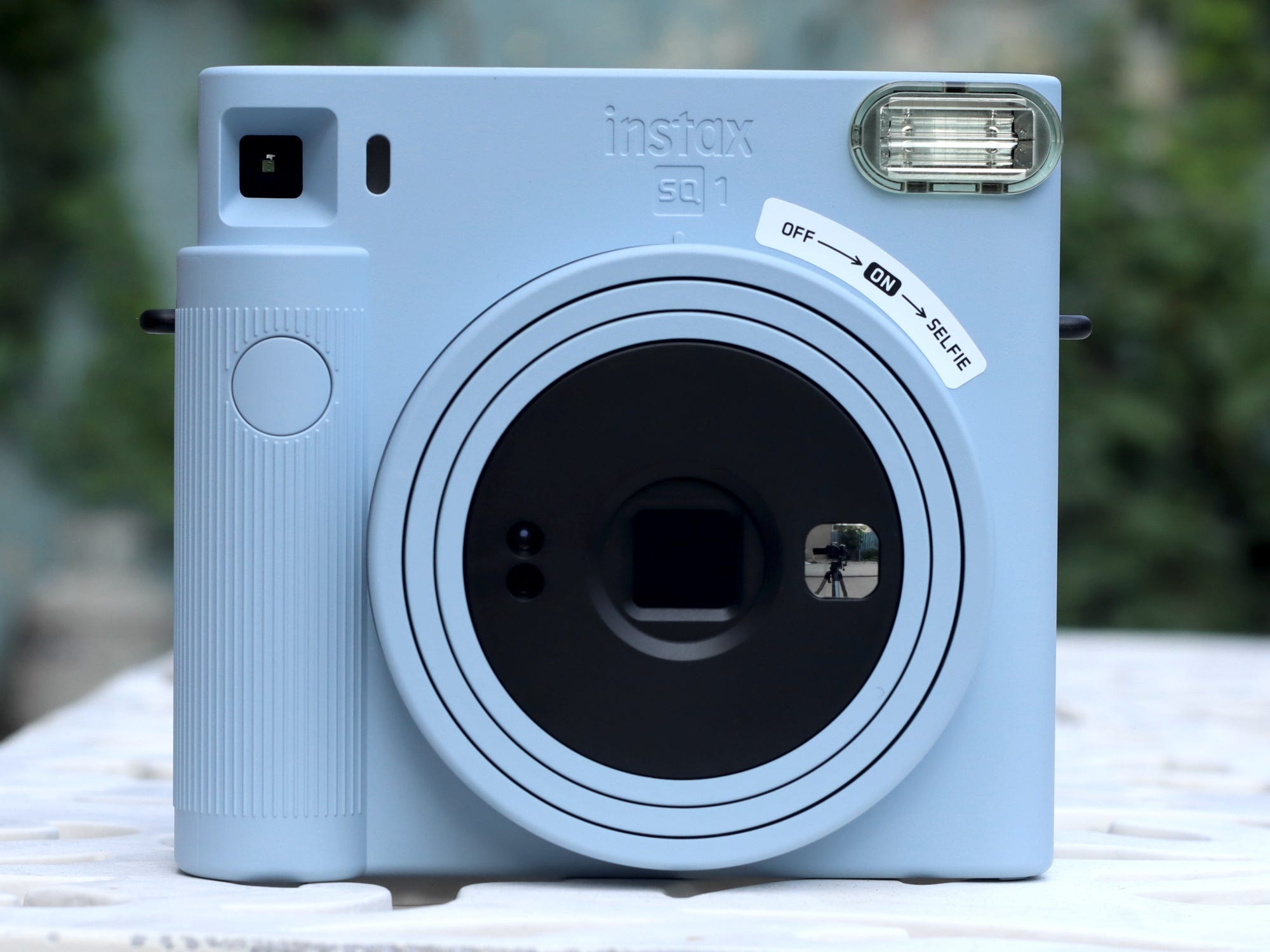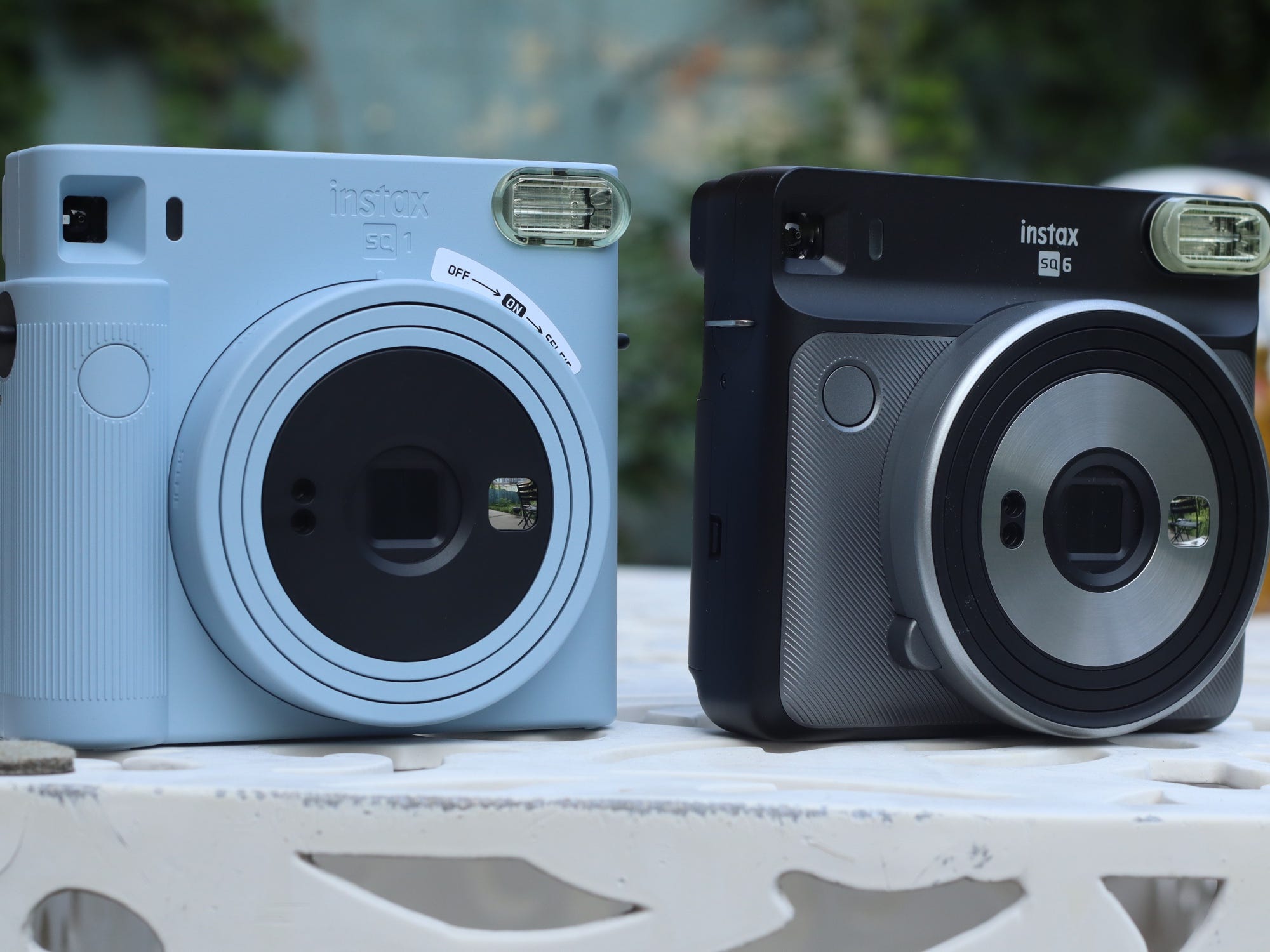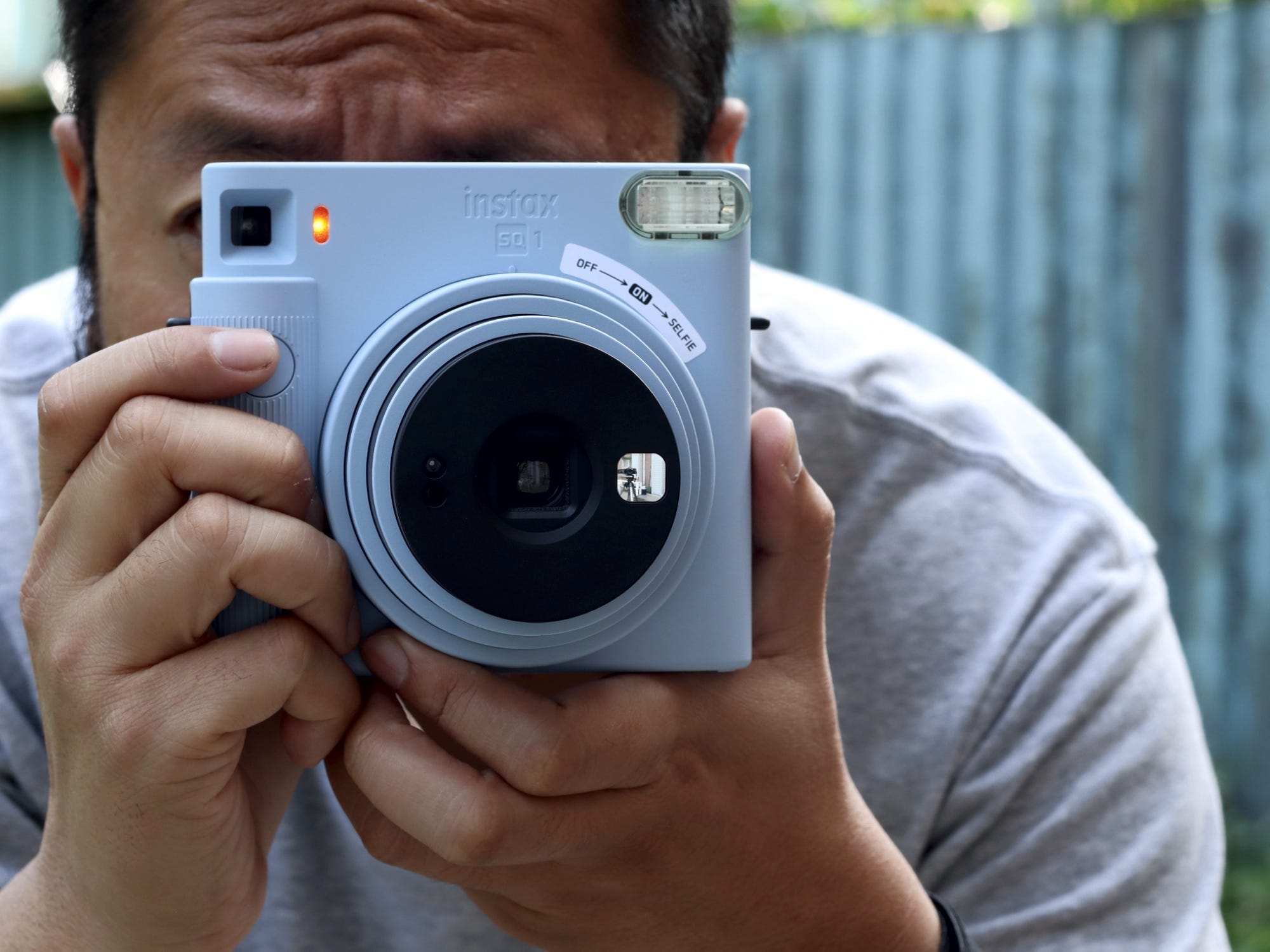When you buy through our links, we may earn money from our affiliate partners. Learn more.

- Fujifilm’s Instax Square SQ1 is its new analog instant camera with square-format film.
- On the SQ1, Fujifilm removed some of the manual controls found on the previous model, the SQ6, and created a point-and-shoot instant camera that’s super easy to use.
- Although the controls are more limited, the improved auto-exposure system in the new Instax Square SQ1 delivers better-looking instant photos than the previous model.
- Despite some drawbacks, the Instax SQ1 is a fun camera to use, and we enjoyed taking pictures with it for our tests.
- It’s a great instant camera for anyone who enjoys instant film photography and wants a fool-proof camera that’s user friendly.
- The camera goes on sale in the US in mid-October, for $120.
The Fujifilm Instax Square SQ1 is the newest member of the wildly popular Instax family of instant film products. Like all Instax cameras, this analog point-and-shoot is fun to use and comes in bright colors. It also uses the square variant of Instax instant film, which has a larger image area that lets you capture more in the shot, whether it’s landscapes or group selfies.
What’s notable with the SQ1 is that it’s entirely automatic. Unlike its predecessor, there are no modes to choose — just press the shutter button and out pops the photo. To compensate, the auto-exposure system has been improved, delivering better-looking images, no adjustments needed.
Easier to use, better exposure

Les Shu/Business Insider
The Instax SQ1 is the second Instax analog camera that uses square film, after the SQ6. In comparison, the SQ1 and SQ6 share a nearly identical boxy form-factor, but the SQ1 is slightly thicker. The SQ1 comes in white, blue, and orange. Some people may prefer these fun colors to the darker metallic options used in the SQ6.
Fujifilm removed the on/off switch and powered retractable lens mechanism of the SQ6 in favor of a manual process on its new camera. To power on the SQ1, you simply rotate the outer part of the lens.
The SQ6 is already easy to use, but Fujifilm made the SQ1 fool-proof. It's completely automatic. With the SQ6, you could select the mode setting — selfie, macro, and landscape. The SQ1 streamlines the process: Rotate the lens once for normal shooting, turn it again for selfies and close-up (macro) photography.
Like the SQ6, the camera exposes automatically, and the flash is enabled always. To frame a shot, there's a small viewfinder; for selfies, there's a small mirror on the front. The film cartridge is easy to load, and there is a counter that shows you how much film is left.

Les Shu/Business Insider
Although Fujifilm's instant film technology hasn't changed, the company does tweak its auto-exposure system with each new camera, to deliver improved picture quality while using the same film.
I've always liked the richer colors of Instax, and while I wouldn't say the SQ1's image quality is dramatically different than the SQ6's in terms of coloring, the SQ1 does deliver more details and contrast. Photos aren't as overexposed, which could result in darker areas depending on the lighting situation. The SQ1 does shoot surprisingly decent photos in low light.
In terms of use, I like the simplicity of having to just press the button. I appreciate the new bump on the front, which provides a better grip on the camera, especially when taking a selfie. It's still not the most comfortable camera to hold, however. I recommend using the included hand strap if you're prone to dropping things.

For power, the SQ1 uses two CR2 disposable lithium batteries (included). It's not a common battery type, but it has a longer lifespan than alkaline AA or AAA. For reference, I'm using the same CR2 batteries that came with my SQ6, which I received in 2018.
Some drawbacks

Les Shu/Business Insider
The improved autoexposure system, ease of use, and ergonomics make the SQ1 a fun camera to use, but because I like having some manual controls, I miss some of the features from the SQ6. While I usually keep the SQ6 in Auto mode, I enjoy the double-exposure function as well as the ability to decrease or increase the exposure.
With the SQ6, I also liked the option of disabling the flash for bright conditions (although the flash is useful for bringing out details in portraits, even when it's very sunny) and a self-timer. Also missing in the SQ1 is a tripod mount, although honestly, I rarely used it, but it is handy when using the self-timer.

Les Shu/Business Insider
The SQ1's build quality is about the same as the SQ6: It's plastic, and it's highly likely it could break if dropped from high up. Fujifilm's products tend to be well-made, although this is not an experiment I intend to try. The battery cover also seems more flimsy than the SQ6's.
My biggest complaint about the SQ1 is its shutter button. Its soft press makes it too easy to accidentally fire a shot, which I did many times. Remember, this is film photography and there are only 10 shots per Instax cartridge, so you need to put some thought into the shot before shooting. The SQ6's shutter button requires a hard press, which prevents any misfires.
Pricing and availability
The Instax SQ1 will be available in mid-October 2020 for $120, in Terracotta Orange, Glacier Blue, and Chalk White. Note that the SQ6 can be found for less than $100, which suggests it's being phased out.
It's hip to be square

Les Shu/Business Insider
The more common Instax instant film you'll see is the Instax Mini, which measures 2.1 by 3.4 inches — roughly the size of a standard business card — with an image area of 1.8 by 2.4 inches, and is used by most Instax cameras.
However, in 2017, Fujifilm launched its first square film, measuring 2.8 by 3.4 inches with an image area of 2.4 by 2.4 inches. While the instant technology is the same, the square film lets you capture more in the picture and create more background blur. It is also reminiscent of Polaroid instant film, albeit smaller (Polaroid is 3 by 3 inches). In my opinion, the square film looks better when framed or stuck to a wall.
The SQ1 is the fourth Instax camera to use the square film. Despite the larger dimensions of the film, the overall size of the camera isn't that much bigger than Instax Mini cameras.

Les Shu/Business Insider
With the launch of the SQ1, Fujifilm is introducing two new film options, one with a rainbow border and a monochrome film. If you're into black-and-white photography, the monochrome film is one to watch. Unfortunately, it wasn't available during my review period.
Film is where things get costly. A twin-pack of 10 Instax square film is approximately $20, while specialty film cost around $15 for just 10. Instant photography is fun, but there is a high cost of ownership if you're trigger-happy.
It's not a nostalgia product
The first consumer instant camera dates back to the late 1940s, with the introduction of Polaroid's Land Camera. While instant photography has often been thought of as legacy technology from a bygone era, the Instax SQ1 — and most Instax cameras from the past few years —is actually designed to be a new product for millennials and Gen-Z in particular.
Fujifilm has had success with Instax thanks to newfound interest from the millennial generation. Like vinyl records, analog instant photography is decidedly "new," original, physically shareable, and cool, as compared to the sameness of digital photography and social media. This is also attributed to the success of Zink instant film technology and the revival of the original Polaroid.
In fact, Fujifilm's Instax business has become more profitable than its digital cameras, thanks to the company's early reinvestment in the technology and marketing it as a toy camera for a new generation. Fujifilm claims Instax sales in 2019 were strong, and it's now looking to capture the Gen-Z market.
This is evident in the SQ1's colors. As mentioned earlier, the body colors pop and are more expressive, and it's as easy to use as a smartphone camera. In comparison, the previous SQ6 comes in darker, metallic colors that can be considered more sophisticated and, perhaps, adult.
The bottom line

The SQ1 may be targeted toward younger generations, but it's also a fun camera for anyone who appreciates film photography. Those of us who grew up with a Polaroid camera probably remember the thrill of taking pictures and seeing them developed in front of our eyes. The SQ1 certainly brings back some of that nostalgia while introducing the medium to a new group of users.
Although I wish Fujifilm retained some of the user-adjustable settings, the improved autoexposure system and ease of use are big improvements over the previous SQ6.
Should you buy it
For what it is, it's a pricey camera that's also costly to maintain in terms of film. But it's unique and offers a more intimate experience that your smartphone can't produce. It lets you share photos physically, and it forces you to offload a photo rather than hiding it away in some digital graveyard. Whether you buy it will depend on your photography needs, but it does make a fun gift.
If price is a concern, check out the older SQ6. You won't get the improved autoexposure system, but it's just as easy to use and you'll get some useful settings not found in the SQ1.
What are your alternatives?

Les Shu/Business Insider
Polaroid is back and its newest instant camera is the Polaroid Now i-Type ($99). This modern remake of a classic is just as fun as the SQ1, but it offers a rechargeable battery, self-timer, and double-exposure mode. The film is also larger and while image quality is good, I prefer the richer colors produced with Instax. Polaroid film is also thicker than Instax, and they take slightly longer to expose. If capturing a moment is more important to you than image quality, put the i-Type on your shortlist.
If you like the concept of instant photography but are digital at heart, check out Fujifilm's Instax Share SP-3 printer ($160-$200). Designed to pair with smartphones, the SP-3 lets you print your digital photos onto Instax square film. Unlike the Instax analog cameras, the SP-3 uses a different print engine, and what you get are photos with superb image quality on the same instant film. Through the Instax app, you can also create borders or write notes.
And if square prints don't matter to you, but sharing physical prints does, you may like the new Instax Mini 11 ($70). It's similar to the SQ1 but it uses the smaller Instax Mini film.
Pros: Easy and fun to use, good autoexposure system, nice-quality prints, selfie mirror
Cons: Pricey to maintain, shutter button too easy to press, no user-adjustable settings, flimsy battery door
